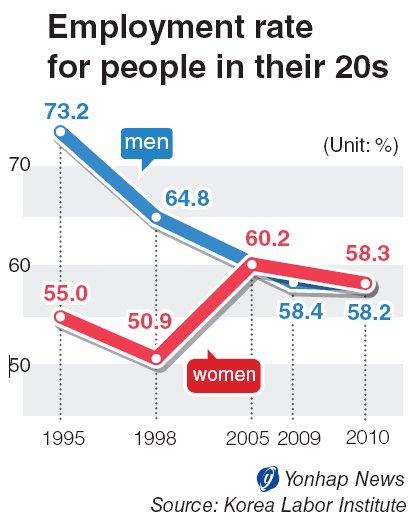More women and fewer men in their 20s land jobs during past 15 years
“While men have had a hard time looking for jobs after the Asian financial crisis in 1997, which forced many businesses to undergo sweeping restructuring and downsizing programs, women have shown a small but ongoing increase,” the report said.
The reason for the decline in employment is the growing number of university graduates creating hectic competition, Seong explained.
While only 34 percent of those aged 20 and 21 were university students in 1995, they soared to 51.7 percent in 2010.
“Overall employment among those in their 20s is expected to be stagnant for some time,” the researcher said.
According to online recruiter InCruit, a jobseeker sends out resumes to an average of 20 companies before landing a job.
Kim Eo-jin and Lee Mi-sun both graduated from university this year and are looking for jobs. Kim, who has done a handful of internship programs at many companies, said none of his experience has led to his landing a a regular job, so he still struggles to make both ends meet.
“Most of my friends are in the same situation. Those who gets hired right after graduation are considered extremely lucky,” he said.
What offends Lee, who majored in history, is the government’s selective perception toward the employment issue. Recently, Bahk Jae-wan, minister of strategy and finance, cited Statistics Korea data saying that the number of newly hired youths marked 500,000 in October and that it is a “jackpot.”
The statistics institute also announced that the unemployment rate here was less than 3 percent in the first half of the year, the lowest in nine years. It was later revealed that the authorities had excluded the long-term unemployed who have “unwillingly” stopped job searching from the data collection.
The administration’s announcement faced criticism from young job seekers. The National Assembly Research Service said the actual unemployment rate, reflecting both voluntary and involuntary unemployment rates, stood at 11.3 percent among those in their 20s and 30s.
“The government has been ineffective in looking into the real lives of people. There are no jobs,” Lee said, adding that she has applied to 24 companies since graduation.
Prime Minister Kim Hwang-sik on Tuesday ordered the administration to develop a new employment index that reflects the reality. “Data that does not reflect the needs of the people will be distrusted,” he said.
According to the Statistics Korea, the nation’s employment rate stands at 63.3 percent but is still below the OECD member state average of 64.6 percent. Korea ranks 21st among 34 members.
By Bae Ji-sook (baejisook@heraldcorp.com)The gender gap in employment has narrowed over the past 15 years as more women in their 20s end fewer men have been hired.
According to a report by Seong Jae-min, senior researcher at the Korea Labor Institute, the employment rate of 20-something men was 73.2 percent in 1995 but dropped to 58.2 percent in 2010. The rate for women stood at 55 percent in 1995 but rose to 58.3 percent in 2010.






